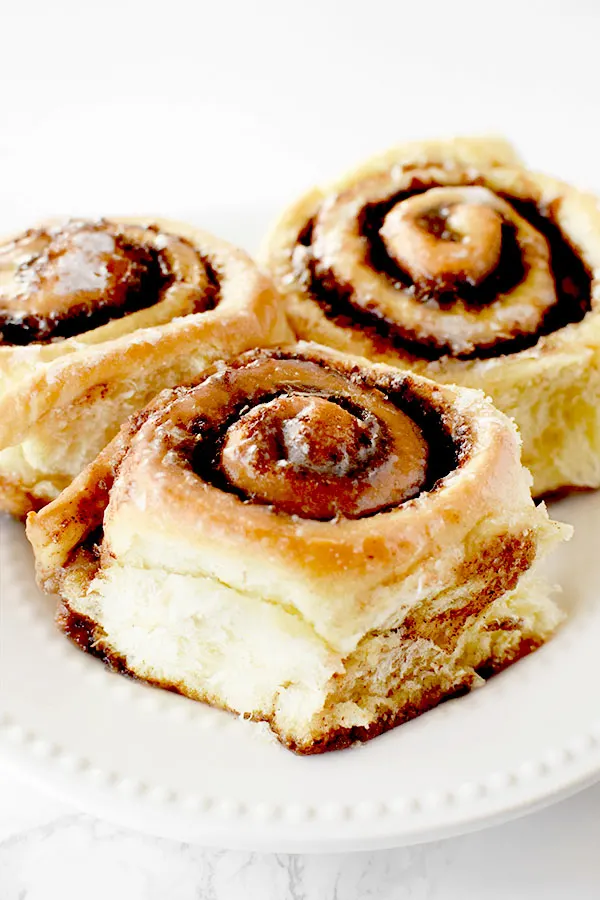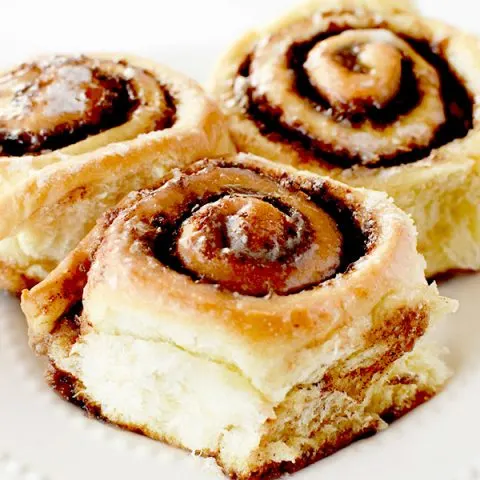This cinnamon roll icing is made without cream cheese and is incredibly easy to make! If you’re avoiding cream cheese, I realize there is a good chance that you are avoiding dairy as well, so this recipe is made with that in mind.

If I have one guilty pleasure, it is cinnamon rolls.
I may love them almost as much as my mom’s incredible dairy free pumpkin pie, but that is a guilt free pleasure because I love it too much to feel guilt about indulging in it.
The one thing I don’t love about cinnamon rolls is the icing.
Don’t get me wrong, cream cheese frosting is delicious! But I don’t enjoy having to make it.
Not to mention, it is not dairy free, and just about all my desserts are dairy free, and how’s a girl to make dairy free cinnamon rolls with cream cheese?
So, I made this cinnamon roll icing without cream cheese and it couldn’t be more perfect on the cinnamon rolls!
Is this recipe dairy free?
Yup, as long as you use dairy free milk or water.
However, if you are not dairy free, you can use regular milk.
Sugar
The primary role of sugar is to be a sweetener. However, sugar also contributes to the tenderness and moistness of the baked good by absorbing and retaining moisture and helps create the golden brown color when baking as it caramelizes.
Recipes with more sugar often result in softer, moister textures. However, I learned the hard way that too much sugar leads to a sticky mess.
When it’s heated, sugar caramelizes, resulting in a rich, complex flavor and a brown color. This adds both flavor and color to baked goods and is also the process in which caramel sauce, dulce de leche, caramel candies, and regular candies are made.
When used in recipes containing yeast, the sugar is eaten by the yeast, producing carbon dioxide and causing the dough to rise.
Sugar also acts as a preservative in jams, jellies, and fruit preserves by reducing water activity and preventing microbial growth.
There are many different types of sugar, including white sugar, brown sugar, vanilla sugar, powdered sugar, turbinado sugar, and demerara sugar.
When a recipe calls for “sugar” without specifying anything else, it’s referring to regular white sugar.
White Sugar
White sugar (sometimes called granulated sugar, table sugar, or white granulated sugar) is made of either beet sugar or cane sugar, which has undergone a refining process.
It is the easiest to find and most commonly used.
Brown Sugar
Brown sugar is white sugar with molasses added to it.
It is commonly used in chocolate chip cookie recipes, and it’s rare for a recipe that calls for brown sugar not to also call for white sugar as well.
When a recipe calls for “brown sugar” but doesn’t specify what type (light or dark), it is referring to light brown sugar.
In my recipes, you can use whatever type of brown sugar you have on hand, whether it is dark brown sugar, light brown sugar, or demerara sugar – which is very common in Israel.
Just keep in mind that the flavor and color will be slightly different, depending on what you choose to use.
Turbinado Sugar
Turbinado sugar is better known as “raw sugar.” But, despite this name, the sugar is not really “raw.”
Instead, it’s partially refined sugar that retains some of the original molasses.
The term “raw sugar” may also give off the impression that it is somehow healthier.
In reality, turbinado sugar is nutritionally similar to white sugar.
Demerara Sugar
Demerara sugar is very popular in Israel and is especially delicious in tea, but is also used for baking.
Unlike white sugar, demerara sugar undergoes minimal processing and retains some vitamins and minerals.
However, it is still not much healthier than white sugar.
Vanilla Sugar
Vanilla sugar is not very common in the States. However, it is common in Israel and parts of Europe.
This is sugar that sat for an extended period of time with vanilla beans, giving it a vanilla flavor.
Caster Sugar
This type of sugar is common in the United Kingdom.
It has a grain finer than white (granulated) sugar and larger than powdered sugar.
Caster sugar is often called for in recipes for delicate baked goods like meringues, souffles, and sponge cakes.
You can use a 1:1 conversion rate between caster sugar and white (granulated) sugar.
Powdered sugar
Powdered sugar, sometimes known as confectioners’ sugar, is a sugar with a powdered texture.
This sugar is rarely used for baking. Instead, it is used for dusting desserts and making frosting, icing, and glazes.
In some countries, you can also find powdered vanilla sugar.
It is made the exact same way regular vanilla sugar is made. However, the sugar used is powdered instead of granulated.
Vanilla Extract vs Vanilla sugar
In my recipes, I don’t specify what kind of vanilla to use.
The reason for this is that in the States, vanilla extract is exclusively used.
Meanwhile in Israel, along with many European countries, vanilla sugar is common.
In most, if not all recipes, both vanilla extract and vanilla sugar can be used.
In recipes where vanilla sugar can be used instead of extract, you can replace them 1:1.
Replacing Sugar with Honey
If you’d prefer to use honey instead of sugar, you can do so with pretty good results.
Honey can be two or even three times as sweet depending on the honey, so for every 1 cup of sugar, you can use 1/2 to 2/3 cup honey.
Since honey adds liquid, you need to remove some to balance it out. For every cup of honey, remove a 1/4 cup of liquid.
Also, it burns faster than granulated sugar, so you want to lower the baking temperature by 25 F. In addition, check it early and often to avoid burning or overbaking.
How to Store Sugar
Sugar should be stored in an airtight container to prevent clumping and moisture absorption, and kept in a cool, dry place.
Which dairy free milk should I use?
Honestly, it’s whatever you have on hand or prefer.
My go-to is a neutral flavored full fat oat milk because I find that they are the most similar to regular full fat milk.
Almond milk works well here, too. I personally like using an unsweetened barista almond milk because it is more similar to regular full fat milk, but whatever you have will work.
You can also use coconut milk, though it may have a subtle coconut flavor if you do. Coconut milk has more fat and is similar to using a light cream, but it won’t make a noticeable difference.
I’ve never used soy milk, so I don’t have any opinions on it, but you can use that as well.
Why is water an option?
The truth is, the main thing is to have some sort of liquid to turn the powdered sugar into a syrup of sorts.
The benefit of milk is that it can lend a little opacity to make the glaze even whiter.
Why should the liquid be warm?
Warm liquid is easier to use with powdered sugar than cool liquid. It makes it smoother and more bendable and therefore requires less liquid.
Why should I wait to use the icing until the cinnamon rolls are completely cool?
The icing will react to the heat and melt it. This will give you a glaze instead of an icing.
Cinnamon Roll Icing without Cream Cheese

This cinnamon roll icing is made without cream cheese and is super simple to make!
Ingredients
- 1 and 1/2 cups powdered sugar (150 grams)
- 2 tablespoons water, dairy free milk, or milk, warm
Instructions
- Combine the confectioners' sugar and dairy free milk (or water or regular milk) and mix until you have a nice, thick, smooth glaze. If it is too thick, add more water a 1/4 teaspoon at a time until you achieve the desired consistency.
- Spoon over room temperature cinnamon rolls.
Notes
A great trick when working with dough is to put a little oil on your hands to prevent it from sticking.
Nutrition Information:
Yield:
12Serving Size:
1Amount Per Serving: Calories: 38Total Fat: 1gSaturated Fat: 1gTrans Fat: 0gUnsaturated Fat: 0gCholesterol: 3mgSodium: 19mgCarbohydrates: 7gFiber: 0gSugar: 7gProtein: 1g